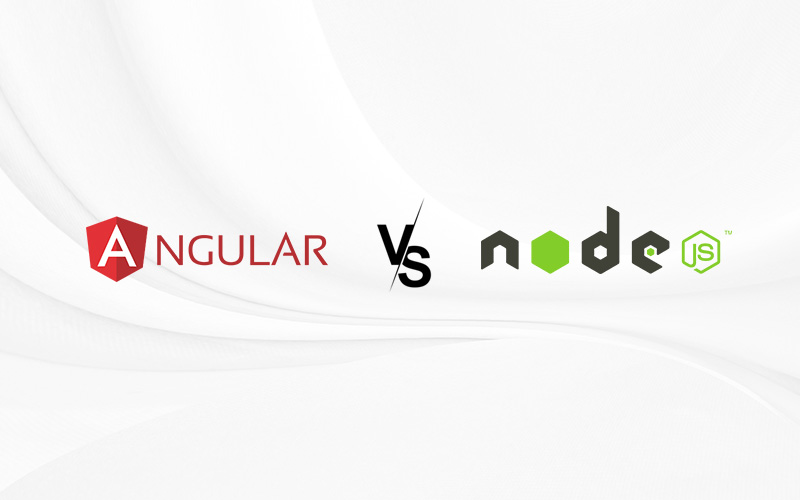Every year, new trends in the creation of mobile and internet applications modify the requirements for programming languages. In addition, functional web development features are available in upcoming programming languages.
Similarly, a survey of developers in 2020 revealed that JavaScript is one of the most widely used technologies.
There are several frameworks available in the internet world, and this blog’s comparison of Nodejs and Angular can help developers decide which is better for their projects.
Using JavaScript, developers may create command-line tools on the open-source Node.js platform. Although TypeScript from Microsoft includes annotations and static typing with generics, Angular advises against using it.
Let’s examine the concepts and variations between Angular and Node js.
What is Node.js, exactly?
Node.js is a JavaScript framework that works with Windows, Linux, Mac OS, Unix, and other operating systems. Before the page is transmitted to the browser, it enables developers to use JavaScript to execute server-side scripts to generate dynamic page content.
It is an event-based architecture and supports asynchronous input and output (I/O). This design choice attempts to increase production and scalability in applications, such as real-time applications, that need many I/O operations. In conclusion, Node is a JavaScript framework that’s perfect for building server-side, data-intensive apps.
We observed that Node.js performs better than Django because it is simpler to use and offers web developers more freedom in terms of implementation. It facilitates web development by providing web developers with access to a large library of JavaScript modules.
Several Features in Node.js
The following are important factors that might affect software developers’ decisions regarding the development of mobile applications using Node.js.
Based on the Google V8 JavaScript Engine, it has the Node.js library built in, which speeds up code execution.
Data is not buffered in Node.js applications. For developers, they process data in bulk.
Each and every event-based, asynchronous application programming interface (API) in the Node.js library.
It is expressly claimed to be non-blocking. While awaiting an API, a Node.js server does not experience data regression. In order for the server to get a response from the previous API request, some server adjustments to the subsequent APIs and Event notification systems are necessary.
What is Angular, exactly?
Angular is a framework for building single-page apps that combines TypeScript with HTML. It was created in TypeScript and functions as a collection of TypeScript libraries that are loaded into applications to offer supplementary and essential functionality.
This open-source front-end framework is managed by the Google Angular Team in collaboration with several groups and individuals.
Based on a few core concepts, the structural architecture of an Angular application is built. They organize related code into attractive groups. These programs often have multiple feature modules and always include a root module to aid with bootstrapping.
The Characteristics of Angular
The following are some important factors that influence developers’ decisions to use Angular as their web framework:
Creating codes: For JavaScript virtual devices, Angular can transform templates into incredibly efficient codes. It offers programmers all of the benefits of manually created scripts as well as the effectiveness of the framework.
Progressive web apps’ quick loading times and one-step installation make them ideal for creating cutting-edge online platforms.
Native applications: Using Ionic, NativeScript, or Cordova approaches, developers may create native apps.
Code splitting: Angular front-end apps load rapidly thanks to a new component router that supports automatic code splitting. Users can therefore simply load the code necessary to provide the desired display.
Desktop apps: On Linux, Mac, and Windows, the same techniques may be used to create desktop-installed programs. Developers may also work with native OS APIs thanks to it.
Templates: Use templates to quickly build UI views using clear and powerful syntax.
Angular CLI: These command-line tools (CLI) help developers create apps rapidly, include tests and components, and launch them right away.
Integrated Development Environments (IDEs) and well-known editors can offer quick feedback, intelligent code completion, and other features.
The Primary Differences between Angular and Node.js
Node.js and Angular are different and special in many ways. These technologies each have a unique set of features and advantages.
Most of the server-side scripting in the creation of the backends of web apps uses Node.js. Even though Angular is one of the best JavaScript front-end frameworks for building adaptable web application interfaces, it has certain drawbacks.
Due to the popularity of both frameworks, a detailed comparison of Angular and Node js might help you understand some significant differences.
Conclusion
When comparing Angular with Node js, we can observe that both frameworks offer unique features and distinctions that support the creation of dynamic web projects.
The well-known web framework Angular frequently comes with comprehensive documentation, which may help JavaScript developers find technical solutions and solve problems rapidly. On the other hand, Node.js is superior at building scalable web servers and apps for the web.
Get in touch with RedBerries to find the framework that will work best for your business and to benefit from its special qualities.






